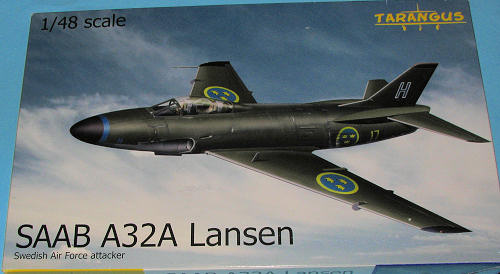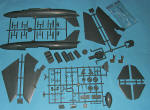
| KIT #: | TA4801 |
| PRICE: | $116.25 from www.coopersmodels.com |
| DECALS: | At least two options |
| REVIEWER: | Scott Van Aken |
| NOTES: | Short run with resin seats |

| HISTORY |
The Saab 32 Lansen (meaningthe Lance) was a two-seat, high transsonic attack aircraft produced by SAAB from 1955 to 1960 for the Swedish Air Force (Flygvapnet). During its long operational life, the Saab 32 also served as a fighter, reconnaissance, electronic warfare and a target-tug aircraft.
When the A 32A entered service they replaced the last piston-powered SAAB B 18 bomber. Soon after entering squadron service, the J 32 Lansen broke the sound barrier on 25 October 1953 when a production aircraft exceeded Mach 1 in a shallow dive. The J 32 carried four 30 mm ADEN cannons while the A 32 ("A" stands for attack) had an armament of four 20 mm Bofors m/49 cannon hidden under flaps in the nose and the Rb 04C anti-ship missile, one of the earliest of its type in western service. The Lansen normally was fitted with two missiles but it could also carry an additional missile. Its main role was to prevent any Soviet invasion across Sweden's extensive coastline.
One planned use of the A 32A was to deliver nuclear warheads or chemical weapons. Sweden had an active nuclear weapons program during the 1950s and 1960s, but no weapons were ever produced.
The A 32 Lansen was Sweden's last purpose-built attack aircraft. Throughout the Cold War years, the Lansen distinguished itself with a solid if unspectacular career; Swedish pilots often described it as pleasant to fly. Gradually being replaced by more modern types, the Saab 32 soldiered on into the late 1990s. Two still remain operational with the sole task of taking high altitude air samples for research purposes in collaboration with the Swedish Radiation Safety Authority. One of those has been used to collect volcanic ash samples in April and May 2010.
| THE KIT |
 Looking very much like an MPM designed kit, the molding is engraved and a tad on the soft side when compared to main line injection molded kits. There are ejector towers in several of the large parts that will need to be removed prior to construction. All of the sprues were packaged in a single zip bag with about a half dozen parts freed from their sprues. The clear bits are well done, though perhaps a tad thick. It is designed to be modeled in the closed position as there is no extension jack or inner canopy detail. Resin is used for the two seats. There is no photo etch and no belt detail on the seats.
Looking very much like an MPM designed kit, the molding is engraved and a tad on the soft side when compared to main line injection molded kits. There are ejector towers in several of the large parts that will need to be removed prior to construction. All of the sprues were packaged in a single zip bag with about a half dozen parts freed from their sprues. The clear bits are well done, though perhaps a tad thick. It is designed to be modeled in the closed position as there is no extension jack or inner canopy detail. Resin is used for the two seats. There is no photo etch and no belt detail on the seats.
The cockpit is fairly well appointed with the aforementioned seats, control sticks and instrument panels. There is nicely raised detail on the side consoles. The instrument panels have indentations where the instruments should go. There is no instrument panel decal so one is on their own in this regard. No sidewall detail is provided. There are actually two cockpit assemblies which are joined in the fuselage. The forward cockpit includes the roof of the nose gear well which has the separate side pieces joined together to complete the well.
Intake trunks are fairly long, though without blanking plates. This may not be needed as there is a compressor face for the inside of the afterburner so there should be no see through situation. There are a myriad of scoops for the upper fuselage that are separate pieces. The nose and main gear are nicely molded. The main gear well goes in the lower wing. Despite a low wing design, the lower wing is two pieces that have an overlapping join. The upper wing halves join to that before installation on the fuselage. Since this is the attack version, lower wing pylons are provided, each of which looks to be slightly different in design so one needs to pay attention during construction. There is an optional outer pylon. No wea pons are provided, which seem to me to be a major omission. Also optional is a belly fuel tank.
pons are provided, which seem to me to be a major omission. Also optional is a belly fuel tank.
Markings are for two aircraft. one in the box art plane which is a restored aircraft from F17 in the standard Olive over unpainted metal. This aircraft uses the larger insignia. The other is from F15 and has the daglo yellow squares as used during an exercise in 1968. The decal sheet is very nicely done and designed for other versions as there are markings not used on this kit.
Instructions are very well printed and provide not only small alignment drawings, but an excellent data placement guide. All of the color information is generic, which is normally not an issue. THe instructions do offer several suggestions to replicate the Swedish Olive Green 325 including FS 34079, Humbrol 116 and Tamiya XF-61. I should also mention that no nose weight information is provided. I would stick something in there just in case.
| CONCLUSIONS |
As a short run kit, this one looks to be quite buildable. The lack of specific placement marks for pylons and antennas may throw some off, but one can pretty well figure out where these go. What I find to be a major issue is the lack of weapons. Swedish weapons are not exactly easily found and while I know this is short run, something should have been included for all those pylons. Still, it should make into a very nice model and is hovering on the top of my 'to do' pile while I wait for a few other projects to be done.
| REFERENCES |
May 2012
Thanks to www.coopersmodels.com for the preview kit. Get yours while they still last.
If you would like your product reviewed fairly and fairly quickly, please contact the editor or see other details in the